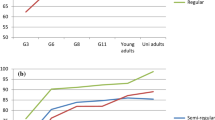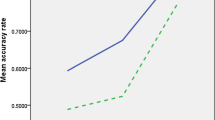Abstract
Grammaticality judgement tasks show that second language learners who started during childhood are significantly more accurate on judging inflection than learners who started after puberty [Johnson, J., & Newport, E. (1989). Cognitive Psychology, 21, 60–99; Johnson, J., & Newport, E. (1991). Cognition, 39, 215–258; McDonald, J. (2000). Applied Psycholinguistics, 21, 395–423. Production data confirmthat inflection is a bottleneck in adult language acquisition, and that they differ from child learners in this respect [Lardiere, D. (1998). Second Language Research, 14, 359–375; Prévost, P. (2003). Studies in Second Language Acquisition, 25, 65–97; Pre vost, P., & White, L. (2000). Second Language Research, 16(2), 103–133]. Although the observations suggest that the acquisition of inflection is influenced by age, there is no study that focuses on this particular issue nor is there an articulated explanation available for the observed age-related difference. In this contribution, we compare child L2 learners of Dutch to child L1 and adult L2 learners of Dutch in order to investigate effects of age on the acquisition of verbal and adjectival inflection. We hypothesize that adult agreement paradigms differ from child agreement paradigms, the reason being that adult learners cannot rely on syntactic cues, whereas children make reliable use of syntax in building paradigms. By effect, adult learners end up with non-targetlike small paradigms that contain underspecified suffixes. We focus on the types of errors in the three learner groups (child L1, child L2 and adult L2). Our empirical basis consists of results obtained in a series of production experiments.
Similar content being viewed by others
References
Adger, D. (2005). Combinatorial variation in inflection. Paper presented at the Workshop variation in inflection 2005, University of Amsterdam, The Netherlands.
Avrutin, S. (2005). What can we learn from comparative psycholinguistics. Paper presented at Generative approaches to Language Acquisition, Utrecht, The Netherlands.
Beard, R. (1982). Is separation natural? Studia Gramatycne, VII, 119–133.
Beard R. (1995). Lexeme-Morpheme base morphology. SUNY Albany Press, Albany, NY
Besten, H. den (1989). From Khoekhoe Foreignertalk via Hottentot Dutch to Afrikaans: The creation of a novel grammar. In M. Pütz & R. Dirven (Eds.), Wheels within wheels; Papers of the Duisburg Symposium on Pidgin and Creole Languages (pp. 207–249). Frankfurt am Main.
Blom, E. (2003). From root infinitive to finite sentence. Doctoral dissertation, Utrecht University.
Blom, E. (2007). Modality, infinitives and finite bare verbs in Dutch and English child language. Language Acquisition, 14(1), (in press).
Blom, E. Testing the domain-by-age-model: Inflection and placement of Dutch verbs. In B. Haznedar & E. Gavruseva (Eds.), Current trends in child second language acquisition: A generative perspective. Amsterdam: John Benjamins (submitted).
Blom, E., & Don, J. (2005). How real are rules of Impoverishment? Paper presented at the Variation in Inflection Workshop, University of Amsterdam, The Netherlands.
Blom, E., & Polišenská D. (2006). Verbal inflection and verb placement in first and second language acquisition. Linguistik International 16, Variation in Sprachtheorie und Spracherwerb; Akten des 39, Maurice Vliegen (red.) (pp. 1–10). Amsterdam: Lang.
Broekhuis, H. (1999). Adjectives and adjective phrases. Modern Grammar of Dutch Occasional Papers 2. T: burg.
Brown R. (1973). A first language: The early stages. Penguin, Harmondworth
van Coetsem F. (1988). Loan phonology and the two transfer types in language contact. Floris, Dordrecht
Deutch W., Wijnen F. (1985). The article’s noun and the noun’s article: Explorations into the representation and access of linguistic gender in Dutch. Linguistics 23(5): 793–810
Elman J. (1993). Learning and development in neural networks: The importance of starting small. Cognition 48(1): 71–99
Felser C., Roberts L., Marinis T., Gross R. (2003). The processing of ambiguous sentences by first and second language learners of English. Applied Psycholinguistics 24: 453–489
Franceschina F., Hawkins R. (2004). Explaining the acquisition and non-acquisition of determiner-noun gender concord in French and Spanish. In: Prévost P., Paradis J. (eds), The acquisition of French in different contexts: Focus on functional categories. John Benjamins, Amsterdam, pp.175-205
Goad H., White L., Steele J. (2003). Missing inflection in L2 acquisition: Defective syntax or L1-constrained prosodic representation?. Canadian Journal of Linguistics 48: 243–263
Goldowsky B.N., Newport E. (1993). Modeling the effects of processing limitations on the acquisition of morphology: The less is more hypothesis. In Mead J. (eds), The Proceedings of the 11th WCCFL. CSLI, Stanford, CA
de Haan A. (1996). De verwerving van de morfologische finietheid in het Nederlands. Groningen, RUG: MA thesis
Haeseryn W., Romijn K., Geerts G., de Rooij J., van den Toorn M.C. (1997). Algemene Nederlandse Spraakkunst. Martinus Nijhoff, Groningen
Halle, M. (1997). Distributed morphology: Impoverishment and fission. In MITWPL 30: Papers at the Interface (pp. 425–449). MITWPL: Cambridge.
Halle M., Marantz A. (1993). Distributed morphology and the pieces of inflection. In Hale K., Keyser S.J. (eds), The view from building 20. MIT Press, Cambridge, Mass, pp. 111–176
Haberzettl, S. (2005). Der Erwerb der Verbstellungsregeln in der Zweitsprach Deutsch durch Kinder mit russischer und türkischer Muttersprache. Tübingen: Niemyer.
Harley H., Noyer R. (1999). Distributed morphology. Glot International 4: 3–9
Haznedar, B. (1997). L2 acquisition by a Turkish-speaking child: Evidence of L1 influence. In E. Hughes, M. Hughes, A. Greenhill (Eds.), Proceedings of the 21st annual BUCLD (pp. 245–256). Somerville, MA: Cascadilla Press, Somerville, MA: Cascadilla Press
Haznedar, B., & Schwartz, B. (1997). Are there optional infinitives in child L2 acquisition? In E. Hughes, M. Hughes & A. Greenhill (Eds.), Proceedings of the 21st Annual BUCLD (pp. 257–268). Somerville, MA: Cascadilla Press.
Hollebrandse, B., & Roeper, T. (1996). The concept of Do-insertion and the theory of INFL in acquisition. In F. Wijnen & C. Koster (Eds.), Groningen assembly on language acquisition (GALA 1995). Groningen: Center for Language and Cognition Groningen.
Johnson J., Newport E. (1989). Critical period effects in second language learning: The influence of maturational state on the acquisition of English as a second language. Cognitive Psychology 21: 60–99
Johnson J., Newport E. (1991). Critical period effects on universal properties of language: The status of subjacency in the acquisition of a second language. Cognition 39: 215–258
Jordens P. (1990). The acquisition of verb placement. Linguistics 28: 1407–1448
van Kampen, J. (1997). First steps in WH movement. Doctoral Dissertation, Utrecht University.
Kiparsky, P. (1973). Elsewhere in phonology. In S. Anderson & P. Kiparsky (Eds.), A Festschrift for Morris Halle. New York: Holt, Rinehart and Winston.
Kiparsky P. (1982). From cyclic phonology to lexical phonology. In: van der Hulst H., Smith N. (eds), The structure of phonological representations (I). Forie, Dondrecht, pp. 131–175
Laloi, A., Spanjaard, R., & Styczynska, J. (2005). Verbal and adjectival flexion by child L2 learners of Dutch. Final paper for ‘Early versus late language acquisition’ University of Amsterdam.
Lardiere D. (1998). Dissociating syntax from morphology in a divergent end-state grammar. Second Language Research 14: 359–375
Lardiere, D. (2000). Mapping features to forms in second language acquisition. In J. Archibald (Ed.), Second Language Acquisition and Linguistic Theory (pp. 102–129) Blackwell.
Marinis T., Roberts L., Felser C., Clahsen H. (2005). Gaps in second language sentence processing. Studies in Second Language Acquisition 27: 53–78
McDonald J. (2000). Grammaticality judgements in a second language: Influences of age of acquisition and native language. Applied Psycholinguistics 21: 395–423
McCarthy, C. (2007). Morphological variability in second language Spanish. Doctoral dissertation, McGill University.
Myles F. (2004). From data to theory: The over-representation of linguistic knowledge in SLA. Transactions of the Philological Society 102: 139–168
Peters, A. M. (1983). The units of language acquisition. Monographs in applied psycholinguistics. Cambridge University Press.
Pienemann M. (1998). Language processing and second language development: Processability theory. John Benjamins, Amsterdam
Pienemann, M., Di Biase, B., Kawaguchi, S., & Håkansson, G. (2005). Processing constraints on L1 transfer. In J. F. Kroll & A. M. B. De Groot (Eds.), Handbook of bilingualism: Psycho-linguistic approaches. New York: Oxford University Press.
Pinker S. (1984). Language learnability and language development. Harvard University Press, Cambridge MA
Pinker S. (1986). Productivity and conservatism in language acquisition. In: Demopoulos W., Marras A. (eds), Language acquisition and concept learning. Ablex Publishing Corporation, Norwood, NJ
Poeppel D., Wexler K. (1993). The full competence hypothesis of clause structure in early German. Language 69: 1–33
Prévost P. (2003). Truncation and missing surface inflection in initial L2 German. Studies in Second Language Acquisition 25: 65–97
Prévost P., White L. (2000). Missing surface inflection or impairment in second language acquisition? Evidence from tense and agreement. Second Language Research 16(2): 103–133
Polišenská, D. (2005). Dutch children’s acquisition of inflection. Paper presented at IASCL 2005, Berlin.
Sabourin, L. (2003). Grammatical gender and second language processing. Doctoral dissertation, Groningen University.
Schwartz B.D. (1992). Testing between UG-based and problem-solving models of L2A: Developmental sequence data. Language Acquisition 2: 1–19
Schwartz, B. D. (2003). Why child L2 acquisition?. In van Kampen J. & S. Baauw (Eds.), Proceedings of GALA 2003 (vol. 1, pp. 47–66), Utrecht.
Schwartz B.D. (2004). Child L2 acquisition: Paving the way. Proceedings of the 27th annual BUCLD (pp. 26–50). Somerville, MA: Cascadilla Press
Schwartz B.D., Sprouse R.A. (1996). L2 cognitive states and the ‘full transfer/full access’ model. Second Language Research 12(1): 40–72
Sorace A. (2005) Syntactic optionality at interfaces. In: Cornips L., Corrigan K. (eds). Syntax and variation: Reconciling the biological and the social. John Benjamins, Amsterdam, pp. 46–111
Snow C., Hoefnagel-Höhle M. (1978). The critical period for language acquisition: Evidence from second-language learning. Child Development 49: 1114–1128
Steinhauer K., Alter K., Friederici A. (1999). Brain potentials indicate immediate use of prosodic cues in natural speech processing. Nature Neuroscience 2: 191–196
Thomason S., Kaufman T. (1988). Language contact, creolization, and genetic linguistics. University of California Press, Berkeley
Tsimpli, I. M. (2003). Features in language development. Paper presented at the Eurosla conference, University of Edinburgh.
Unsworth, S. (2005). Child L2, adult L2, child L1: Differences and similarities. Doctoral dissertation, Utrecht University.
van der Velde, M. (2005). Gender acquisition across languages: Dutch and French compared. Paper presented at IASCL 2005, Berlin.
Verhoeven, L., Vermeer, A., & van de Guchte, C. (1986, 2002). Taaltoets allochtone kinderen: Diagnostische toets voor de mondelinge vaardigheid Nederlands bij allochtone kinderen van 5–9 jaar (TAK onderbouw). Tilburg: Zwijsen.
Weerman F., Bischop J., Punt L. (2006). L1 and L2 acquisition of Dutch adjectival inflection. ACLC Working papers 1(1): 5–36
Zuckerman, S. (2001). The acquisition of “optional” movement. Doctoral dissertation, Groningen University.
Zink, I., & Lejaegere, M. (2002). N-CDI’s: Lijsten voor communicatieve ontwikkeling. Aanpassing en hernormering van de MacArthur CDI van Fenson et al. Leuven: Acco.
Author information
Authors and Affiliations
Corresponding author
Additional information
An erratum to this article can be found at http://dx.doi.org/10.1007/s11525-007-9116-8
Rights and permissions
About this article
Cite this article
Blom, E., Polisšenská, D. & Weerman, F. Effects of age on the acquisition of agreement inflection. Morphology 16, 313–336 (2006). https://doi.org/10.1007/s11525-007-9110-1
Received:
Accepted:
Published:
Issue Date:
DOI: https://doi.org/10.1007/s11525-007-9110-1




